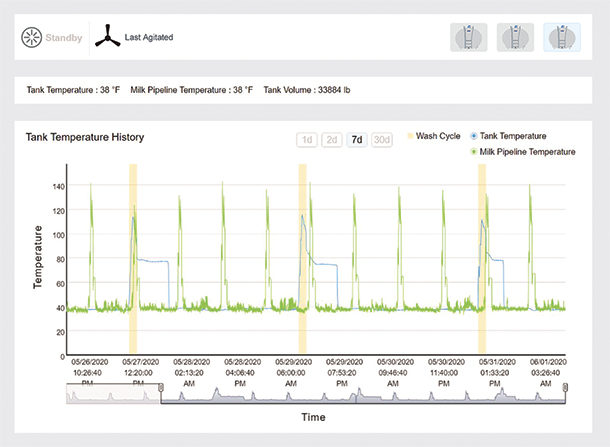As you navigate your way through our hectic world each day, you may have never considered changing where information from your milk cooling system is stored.
Here are a few reasons why you may want to consider putting it on the cloud, which would give you access to this information remotely.
1. Regulatory compliance
Currently, all milk coolers built after 2000 in the U.S. are required to have a time and temperature recorder attached. This results in thousands of paper charts produced each week left hanging on nails in milk rooms across America. These are often mindlessly changed out and stored to meet the guideline of retaining six months of history. When a problem is uncovered, someone combs through the paper, attempting to piece together a story of what happened and when. This is often hindered by the fact that the paper is weathered, and the ink or print quality was marginal in the first place.
Having this same information (and often more) available via the internet can be a game-changer. Looking at data in digital form versus a physical graph makes identifying trends at an earlier stage much easier. Documentation is vastly improved, and overall analysis is less challenging. In addition, the sanitarian, or whoever is given access to this information, can review data from wherever they are and whenever the need arises, providing improved opportunities to minimize quality issues.
2. Alerts and alarms
Digital collection of temperatures with time stamps, along with volume indicators, refrigeration performance monitoring, wash temperatures and more, is a powerful tool for providing operational alerts and potential alarms.

Automated text messages allow dairy managers to quickly respond to potential complications. Image courtesy of Paul Mueller Company.
Milk haulers receive a notification when the storage is full, at temperature and ready for pickup. No more waiting in the dooryard before loading. Logistics planners can glimpse overall volume on an individual farm, or even in a region, for load balancing and processing planning.
Sanitarians are alerted to potential quality problems in real time, helping to avoid loads arriving at the plant with unforeseen issues. The dairy manager is able to quickly respond to potential complications by receiving early alerts that might catch a problem before it becomes a significant breakdown.
3. Efficiency and operational information
Technicians utilize the above information to identify service issues. Additionally, some systems allow the technician to do a deeper dive into the function of each condensing unit, giving them the ability to remote diagnose issues like never before. Analyzing available data can result in significant savings in labor costs and downtime. It also provides the possibility of having a senior, experienced technician monitor the actions of the newer service personnel – ensuring the highest system efficiency and eliminating extra expenses for multiple service calls.
4. Schedule management
Consider this scenario: Milking is supposed to begin at 3 p.m., but you receive an alert that your milk cooler is still 75ºF at 4 p.m. Did something go wrong? Did the milking crew fail to show up? Did they forget to turn the milk cooler on? All of these answers can be found with a quick check of your smartphone, tablet or PC. You can see exactly what the situation is and most likely initiate immediate corrective action before things get out of hand.
5. Peace of mind
More than anything else, having all of this information available remotely provides you peace of mind. You invest hundreds of thousands of dollars for the ability to monitor the cows, their feed, their milk output and more. But often, once the milk is pumped to the milk cooler, you lose sight of your product.
Investing in the ability to monitor and receive automated alarms and alerts of your milk cooling and storage equipment is much like installing a high-tech alarm system on a bank vault. It is a wise investment. Just as the alarm system ensures the protection of your assets, remote monitoring safeguards the quality and salability of your milk, the most significant revenue source on your dairy.










